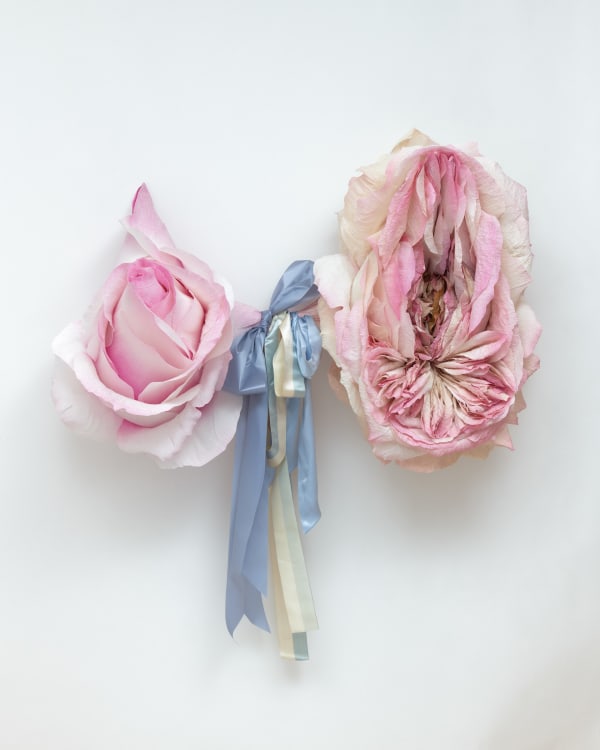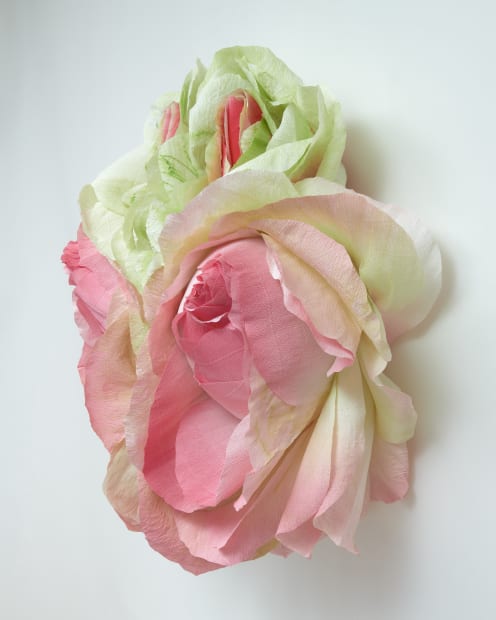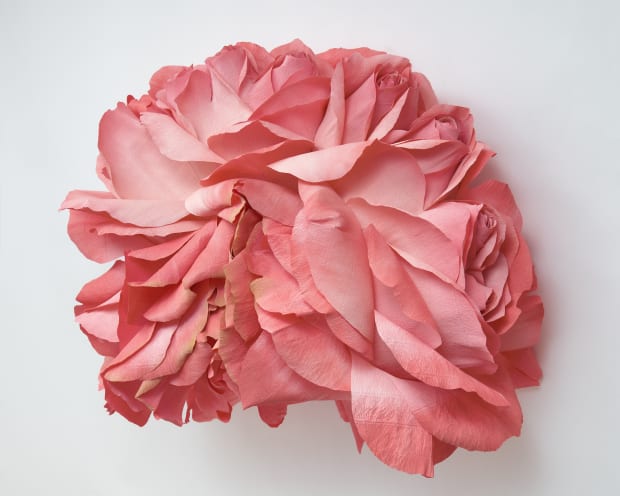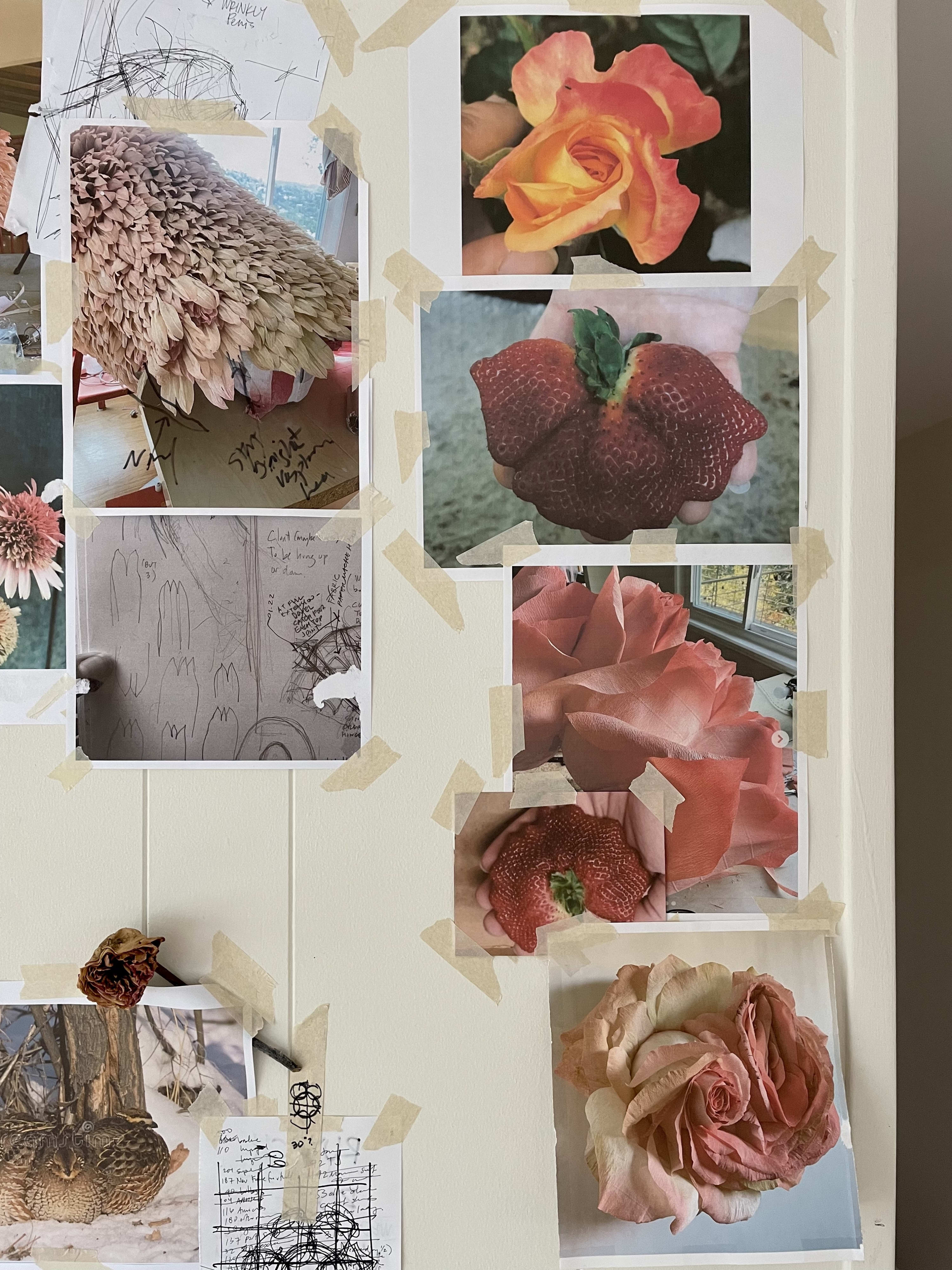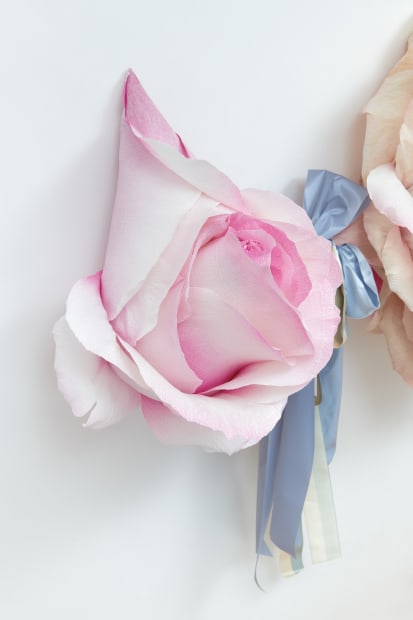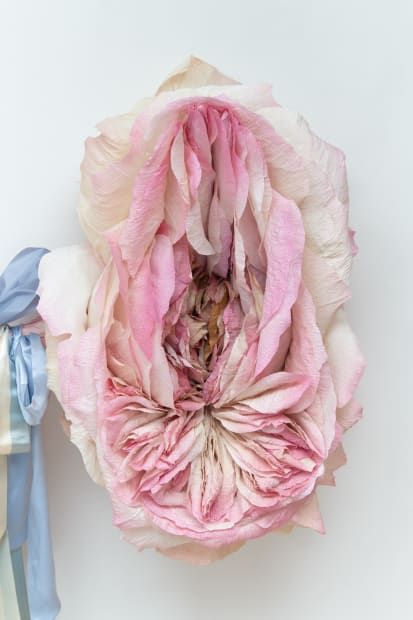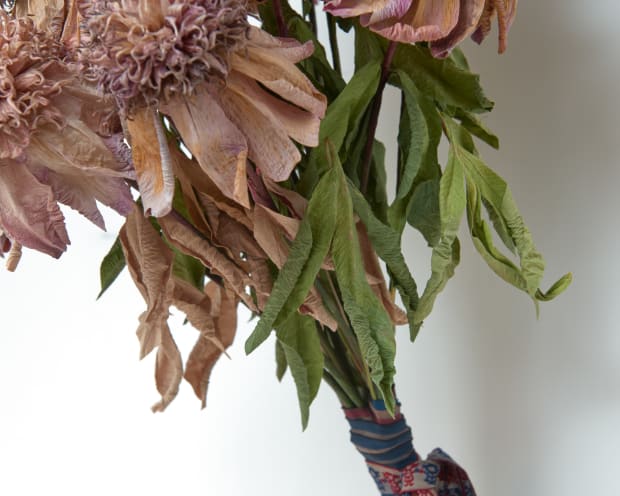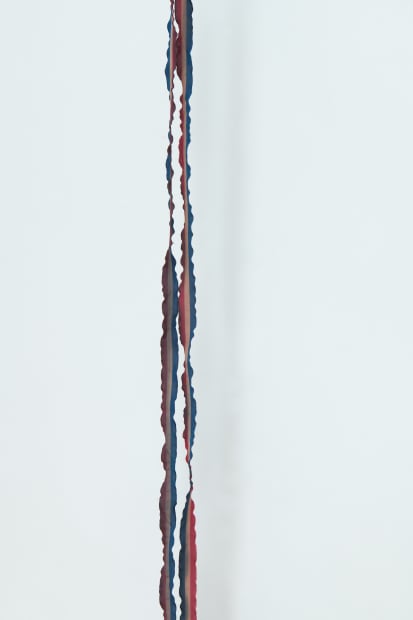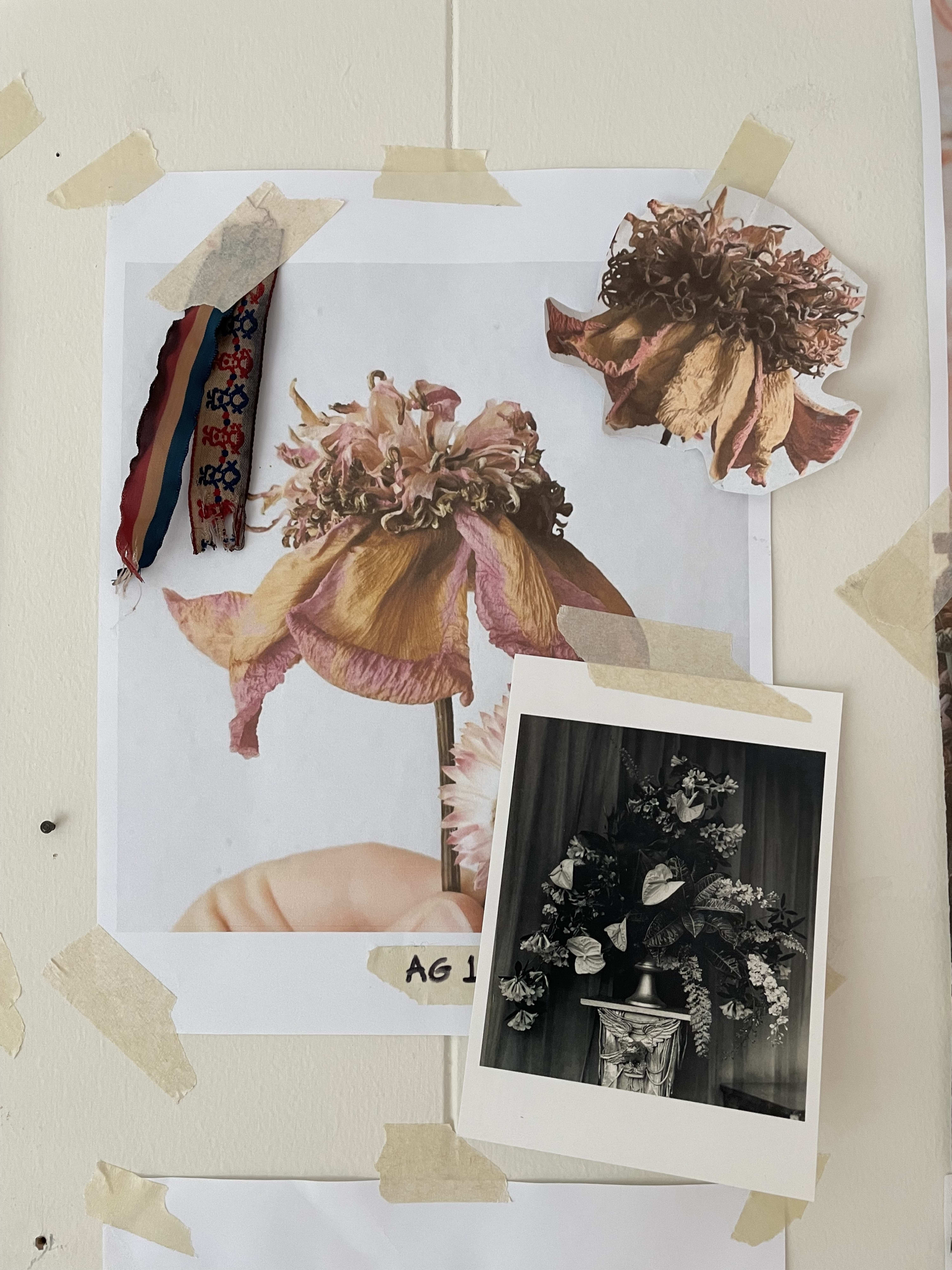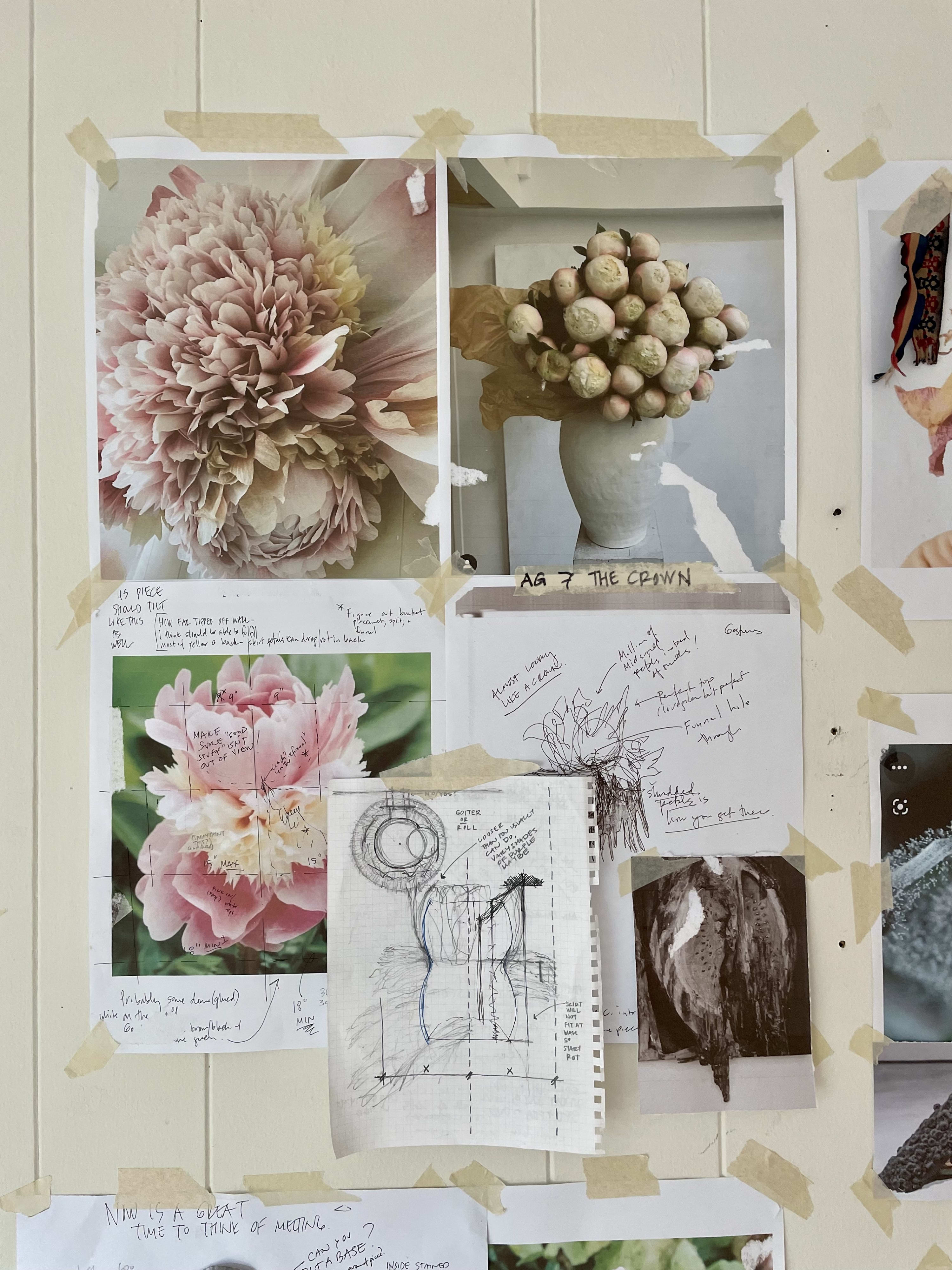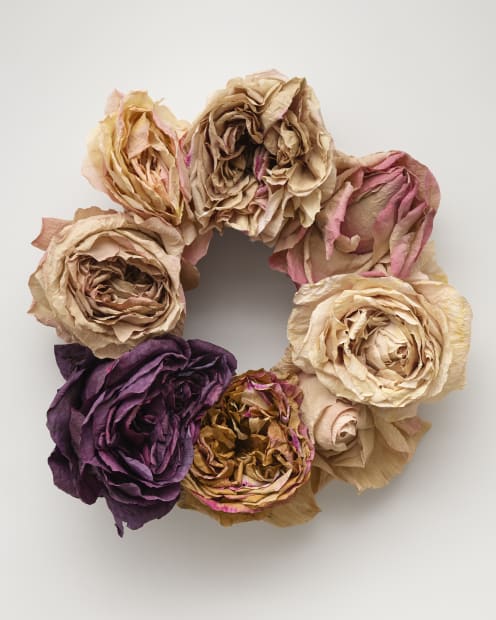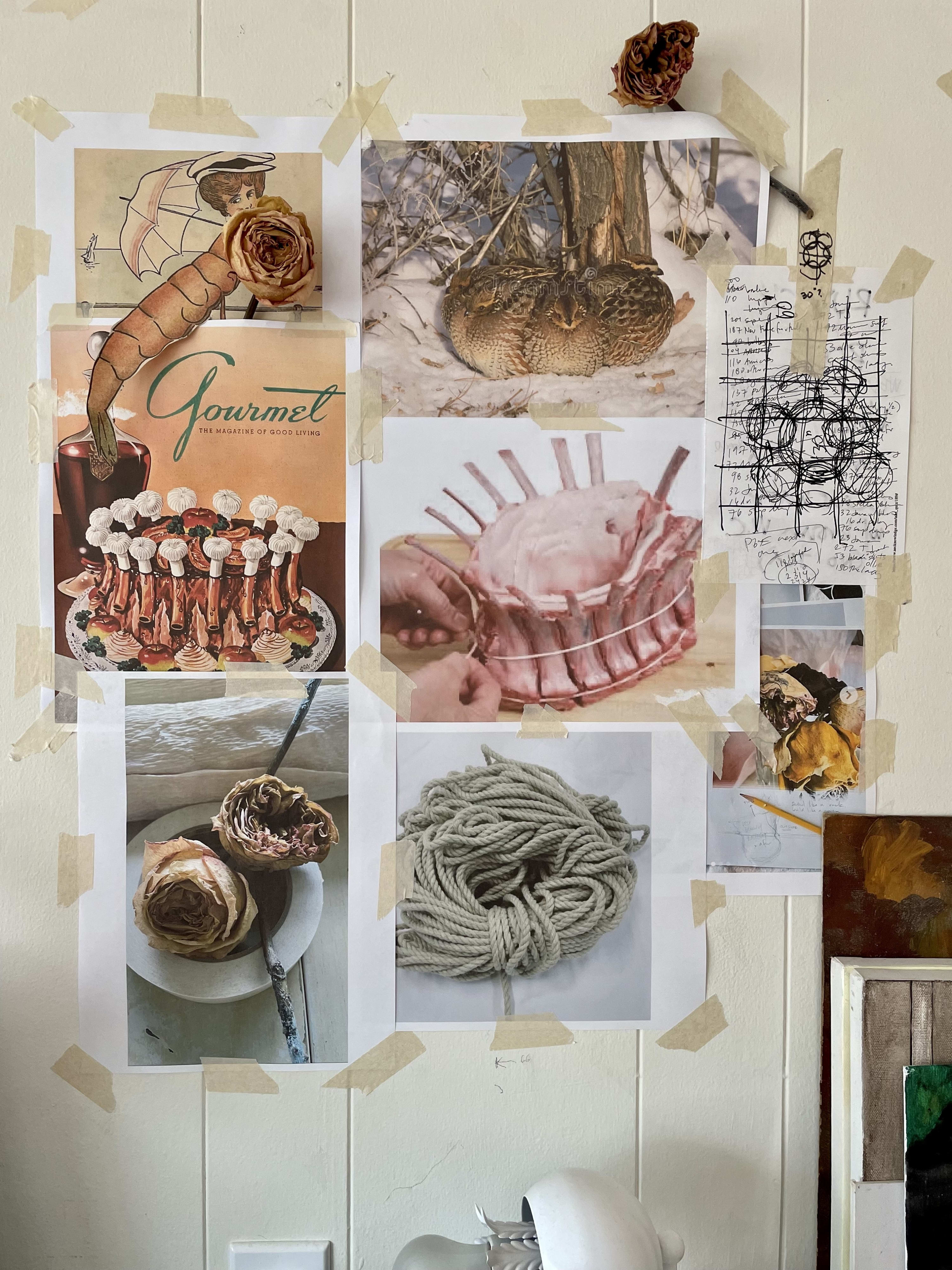Tiffanie Turner's sculptures of flowers deform, reform, pile up, contradict, and contort what we think of as a typical blossom. She pulls focus away from the specific blooms depicted, but uses their floral familiarity and allure to draw the viewer into her artwork and the meaning behind them.
Turner's work connects the associations and formal similarities of certain flowers with recognizable objects and themes to take on agism, sexism, conventional beauty standards, generational differences, marriage, and motherhood. Much of her work is faded, aged, or mutated, all metaphors of the impact of aging on our own bodies as well as a metaphor for some of the darker parts of American culture.
The full body of sculptures in American Grown is the result of two and a half years of work. Turner had three tenets as her guiding principles for American Grown. One, to become "anti-circle," to physically change her work from wall-mounted, front-facing circles, to forms that were conical, multi-directional, angled, upward, mirrored, elongated, and beginning to defy gravity.
Second, after almost a decade of thinking about and staring at nothing but flowers in her work, she sought to draw on resemblances she noticed between flowers and other earthly objects, both natural and manmade. She drew on those resemblances, associations, and formal similarities to imbue meaning into her sculptures.
The third and final tenet was to connect this work back to her childhood, comparing and contrasting the standards and safeguards around the raising of her two children with memories of her grandparents and parents, focusing on the timeframe of 1950 to 2050. Through her use of extraordinary detail and oversized beauty and decay, Turner presents American Grown, a meditation on her own life and American culture.
Tiffanie Turner
American Grown
Sept 9 - Nov 18 2023
-
 Tiffanie TurnerExcerpt from Still Life with Flowers on a Marble Table Top, 2023Paper mâché, Italian crepe paper, stain, glue, wood rods, cardboard31 x 29 x 21 1/2 in
Tiffanie TurnerExcerpt from Still Life with Flowers on a Marble Table Top, 2023Paper mâché, Italian crepe paper, stain, glue, wood rods, cardboard31 x 29 x 21 1/2 in
78.7 x 73.7 x 54.6 cm$ 15,000.00 -
 Tiffanie TurnerOriginalism (December 15, 1791 - present), 2023Italian crepe paper, stain, glue, floral wire, chalk, vintage flag pole holder, ribbons23 x 15 x 14 in
Tiffanie TurnerOriginalism (December 15, 1791 - present), 2023Italian crepe paper, stain, glue, floral wire, chalk, vintage flag pole holder, ribbons23 x 15 x 14 in
58.4 x 38.1 x 35.6 cm
(Ribbon goes to floor)$ 14,000.00 -
 Tiffanie Turner580085, 2023Paper mâché, Italian crepe paper, stain, glue, cardboard, wood rods, rubber balls32 1/2 x 33 x 15 in
Tiffanie Turner580085, 2023Paper mâché, Italian crepe paper, stain, glue, cardboard, wood rods, rubber balls32 1/2 x 33 x 15 in
82.5 x 83.8 x 38.1 cmCourtesy of Eleanor HarwoodCopyright The Artist -
 Tiffanie TurnerThe (Brown) Crown, 2023Paper mâché, Italian crepe paper, stain, glue, wood rods, wood skewers, cardboard mailing tube, basketball hoop frame, misc. hardware bits32 x 38 x 38 1/2 in
Tiffanie TurnerThe (Brown) Crown, 2023Paper mâché, Italian crepe paper, stain, glue, wood rods, wood skewers, cardboard mailing tube, basketball hoop frame, misc. hardware bits32 x 38 x 38 1/2 in
81.3 x 96.5 x 97.8 cm$ 16,000.00 -
 Tiffanie TurnerCroquembouche, 2022Italian crepe paper, stain, glue, floral wire, chalk, chicken egg shells, hat stand, metal platter on pedestal, epoxy adhesive26 1/2 x 15 in
Tiffanie TurnerCroquembouche, 2022Italian crepe paper, stain, glue, floral wire, chalk, chicken egg shells, hat stand, metal platter on pedestal, epoxy adhesive26 1/2 x 15 in
67.3 x 38.1 cm -
 Tiffanie TurnerCockscomb Rose, 2022Paper mâché, Italian crepe paper, stain, spray paint, glue, wood rods, metal rod, cardboard, soft pastel36 1/2 x 45 x 20 in
Tiffanie TurnerCockscomb Rose, 2022Paper mâché, Italian crepe paper, stain, spray paint, glue, wood rods, metal rod, cardboard, soft pastel36 1/2 x 45 x 20 in
92.7 x 114.3 x 50.8 cm -
 Tiffanie TurnerSoup to Nuts, 2023Paper mâché, Italian crepe paper, stain, glue, wood rods, cardboard, ribbons30 x 36 x 17 in
Tiffanie TurnerSoup to Nuts, 2023Paper mâché, Italian crepe paper, stain, glue, wood rods, cardboard, ribbons30 x 36 x 17 in
76.2 x 91.4 x 43.2 cm
Height including ribbon drape is 46 in$ 18,500.00 -
 Tiffanie TurnerByproduct/Burnt Offerings (Ranunculus), 2022Paper mâché, Italian crepe paper, stain, glue, Quik-Tube27 x 27 x 29 3/4 in
Tiffanie TurnerByproduct/Burnt Offerings (Ranunculus), 2022Paper mâché, Italian crepe paper, stain, glue, Quik-Tube27 x 27 x 29 3/4 in
68.6 x 68.6 x 75.6 cm$ 13,000.00 -
 Tiffanie TurnerIndurate (of a size that is remarkable), 2023Paper mâché, Italian crepe paper, stain, glue, wood rods, metal rods, wood slats, Quik-Tube, basketball hoop frame29 x 46 x 58 in
Tiffanie TurnerIndurate (of a size that is remarkable), 2023Paper mâché, Italian crepe paper, stain, glue, wood rods, metal rods, wood slats, Quik-Tube, basketball hoop frame29 x 46 x 58 in
73.7 x 116.8 x 147.3 cm$ 22,000.00 -
 Tiffanie TurnerDid I Win?, 2023Paper mâché, Italian crepe paper, stain, glue, steel aerialist hoop, cardboard, plastic ball50 x 49 x 22 in
Tiffanie TurnerDid I Win?, 2023Paper mâché, Italian crepe paper, stain, glue, steel aerialist hoop, cardboard, plastic ball50 x 49 x 22 in
127 x 124.5 x 55.9 cmCourtesy of Eleanor HarwoodCopyright The Artist
-
580085
Paper mâché, Italian crepe paper, stain, glue, cardboard, wood rods, rubber balls, 32 1/2 x 33 x 15 in -

-
Byproduct/Burnt Offerings (Ranunculus)
Paper mâché, Italian crepe paper, stain, glue, Quik-Tube, 27 x 27 x 29 3/4 in -

-
Excerpt from Still Life with Flowers on a Marble Table Top
Paper mâché, Italian crepe paper, stain, glue, wood rods, cardboard, 31 x 29 x 21 1/2 in -
Still Life with Flowers on a Marble Tabletop, Rachel Ruysch, 1716
oil on canvas, 48.5cm x 39.5cm -
Turner's Idea Board for "Excerpt from Still Life with Flowers on a Marble Table Top"

-
Indurate (of a size that is remarkable)
Paper mâché, Italian crepe paper, stain, glue, wood rods, metal rods, wood slats, Quik-Tube, basketball hoop frame, 29 x 46 x 58 in -

-
Cockscomb Rose
Paper mâché, Italian crepe paper, stain, spray paint, glue, wood rods, metal rod, cardboard, soft pastel, 36 1/2 x 45 x 20 in -

-
Soup to Nuts
Paper mâché, Italian crepe paper, stain, glue, wood rods, cardboard, ribbons, 30 x 36 x 17 in -

-
Originalism (December 15, 1791 - present)
Italian crepe paper, stain, glue, floral wire, chalk, vintage flag pole holder, ribbons, 23 x 15 x 14 in -

-
Croquembouche
Italian crepe paper, stain, glue, floral wire, chalk, chicken egg shells, hat stand, metal platter on pedestal, epoxy adhesive, 26 1/2 x 15 in -

-
The (Brown) Crown
Paper mâché, Italian crepe paper, stain, glue, wood rods, wood skewers, cardboard mailing tube, basketball hoop frame, misc. hardware bits, 32 x 38 x 38 1/2 in -

-
Did I Win?
Paper mâché, Italian crepe paper, stain, glue, steel aerialist hoop, cardboard, plastic ball, 50 x 49 x 22 in -








